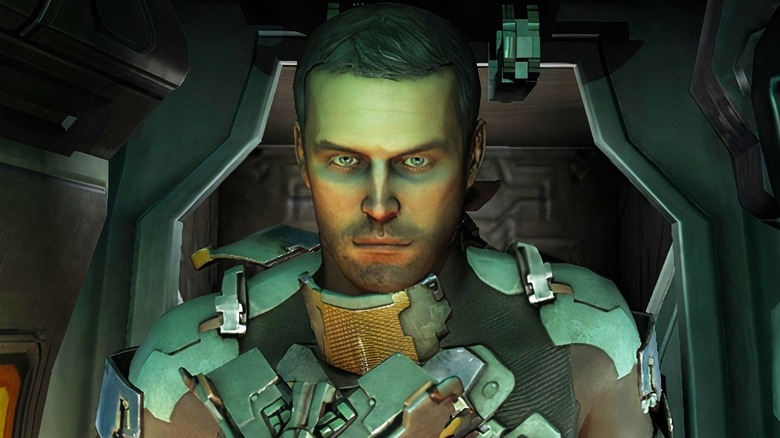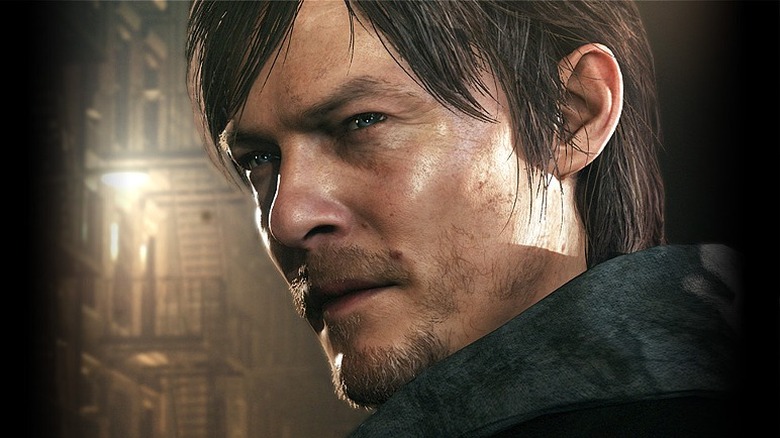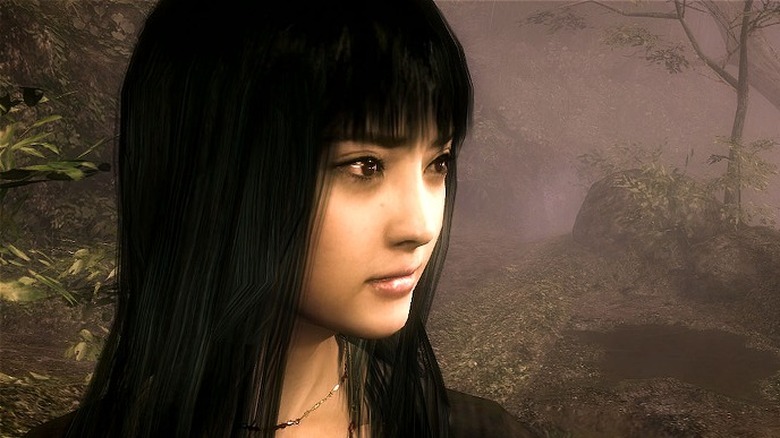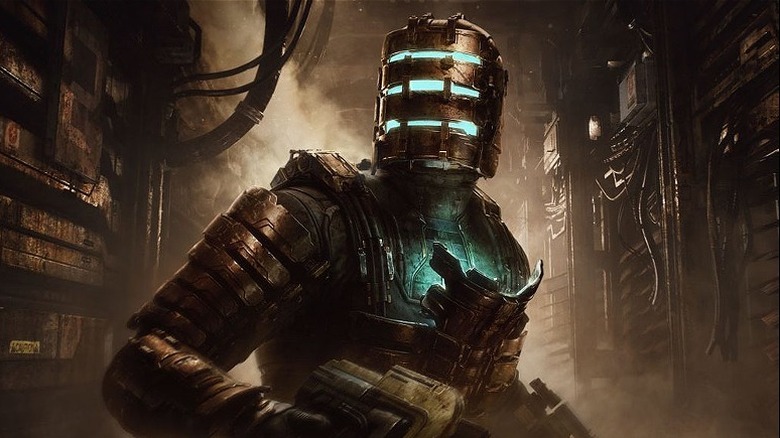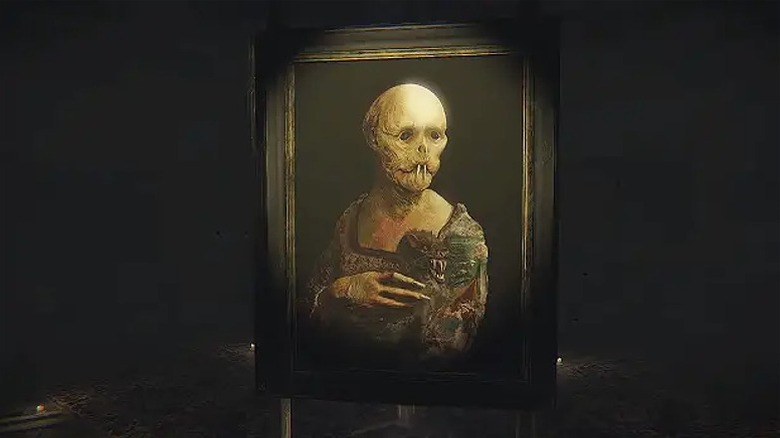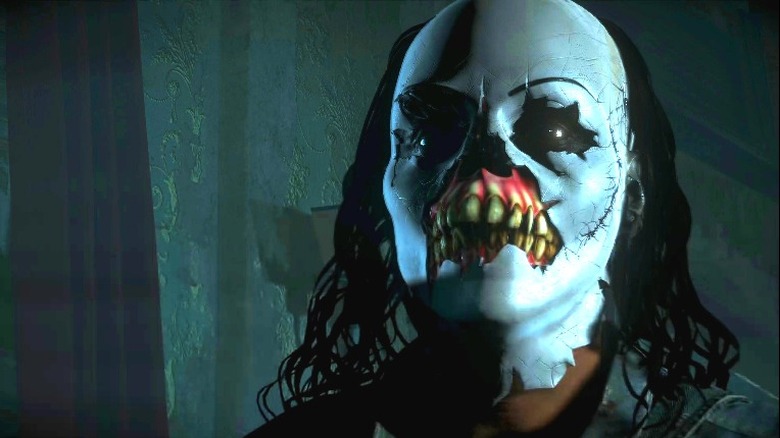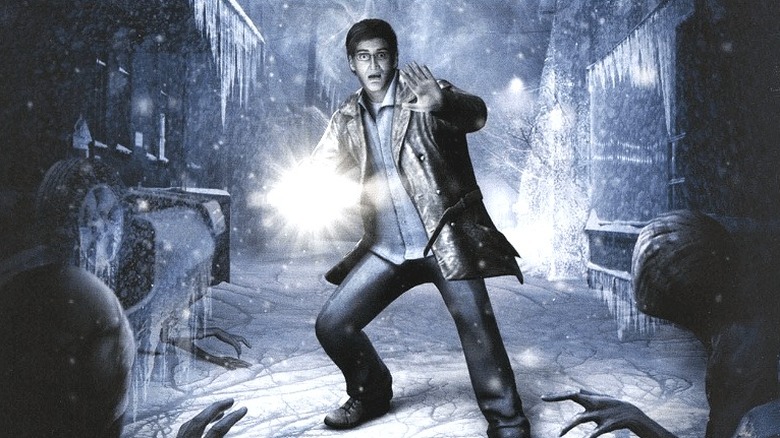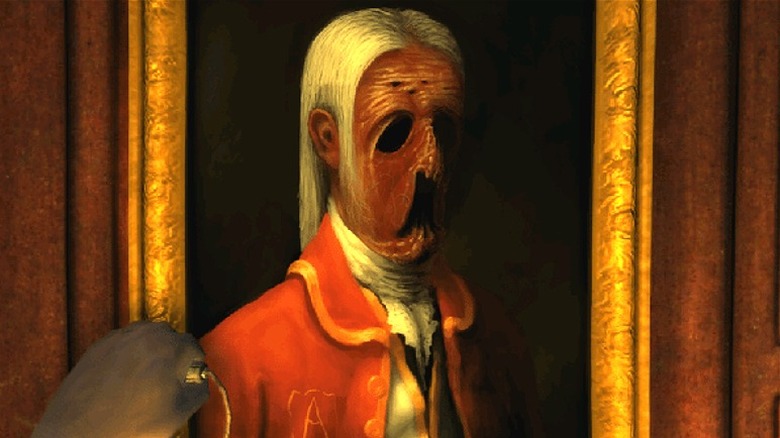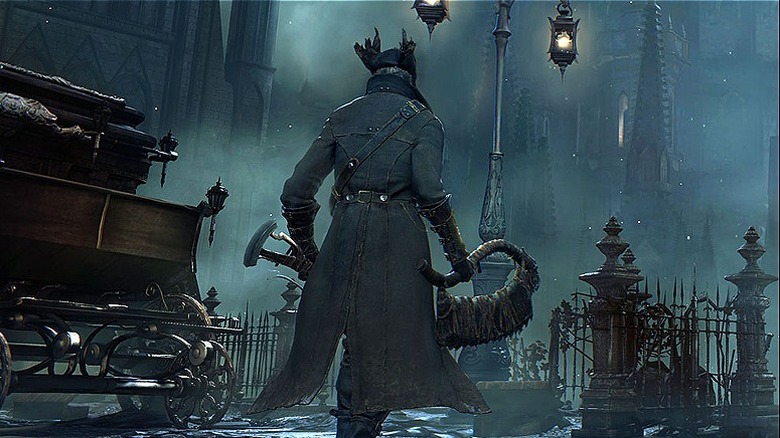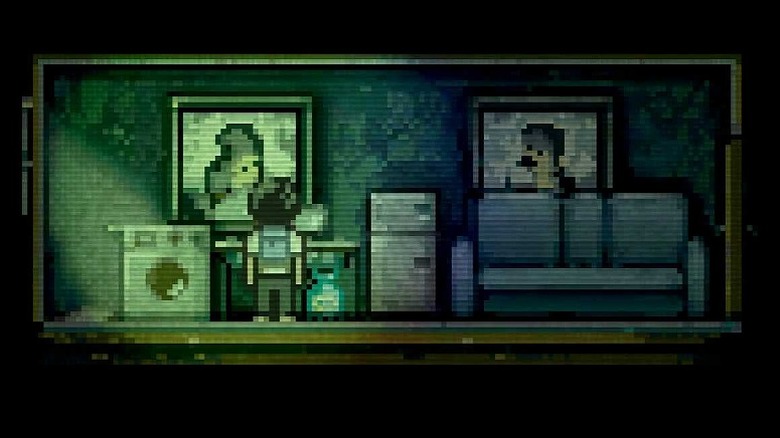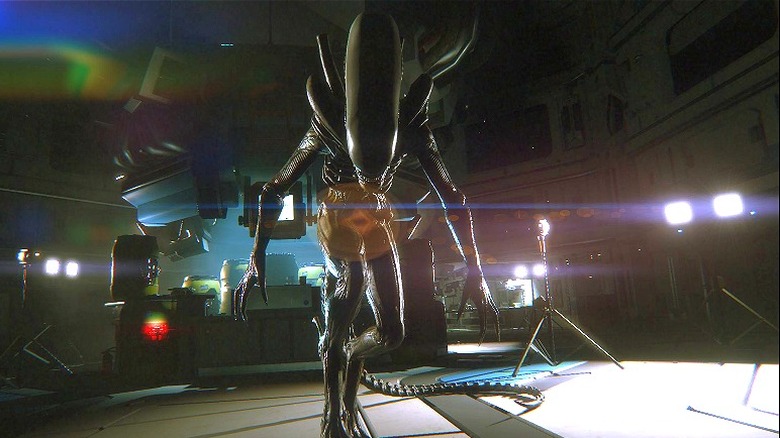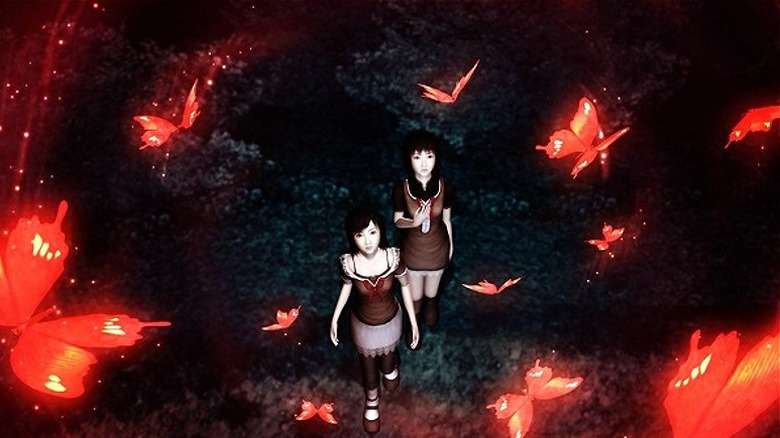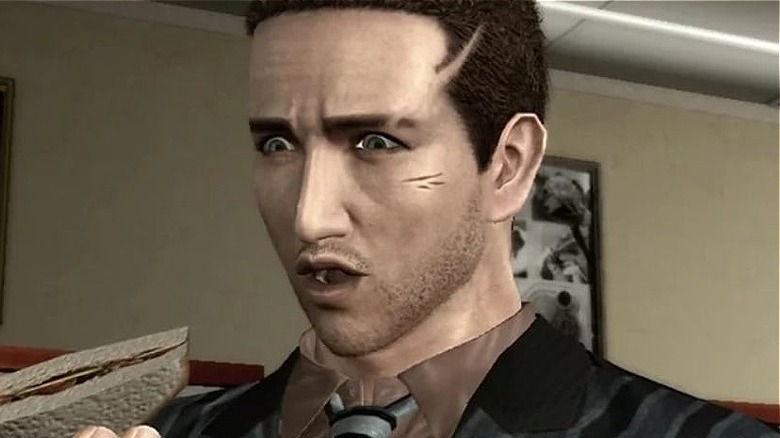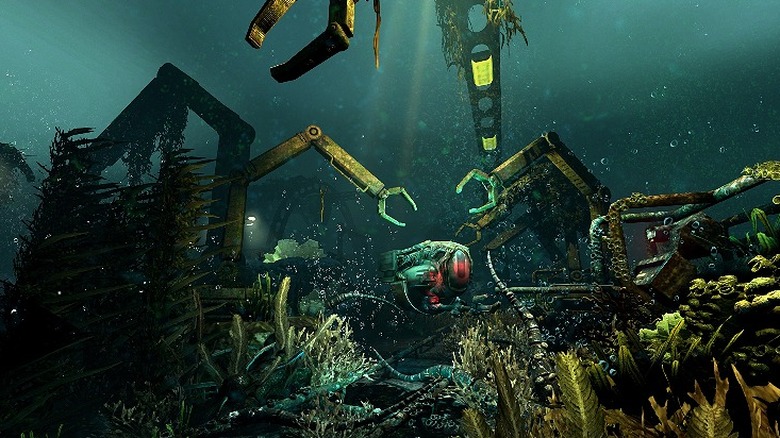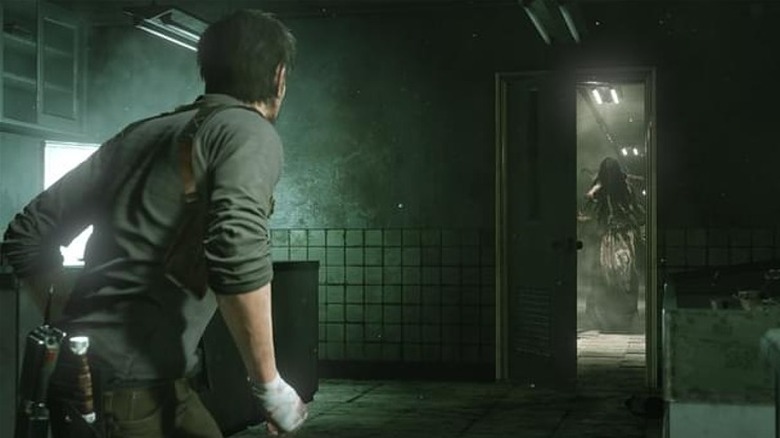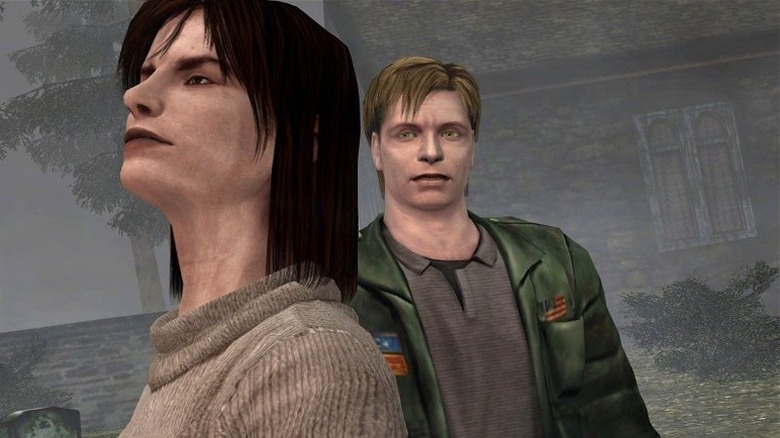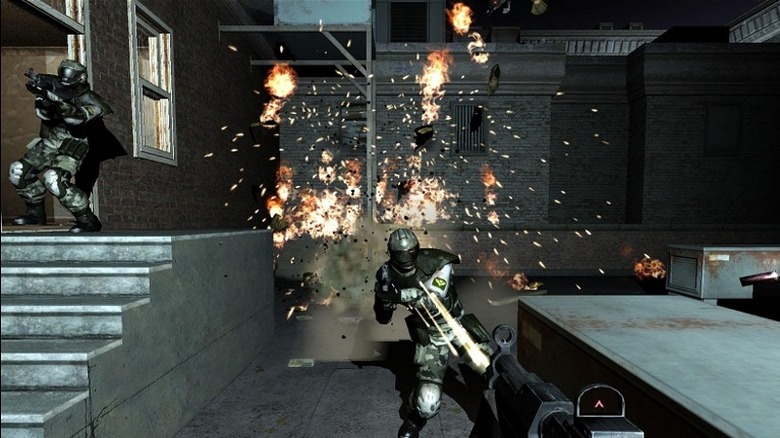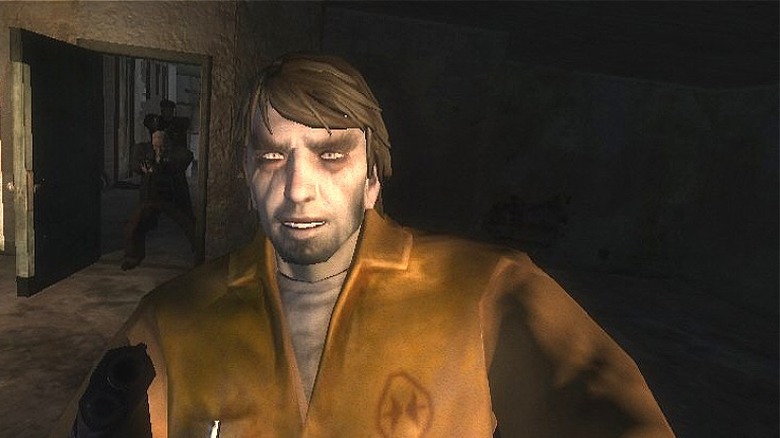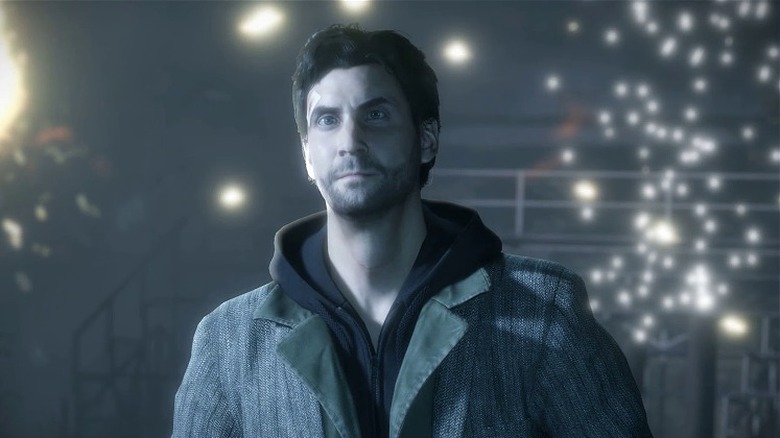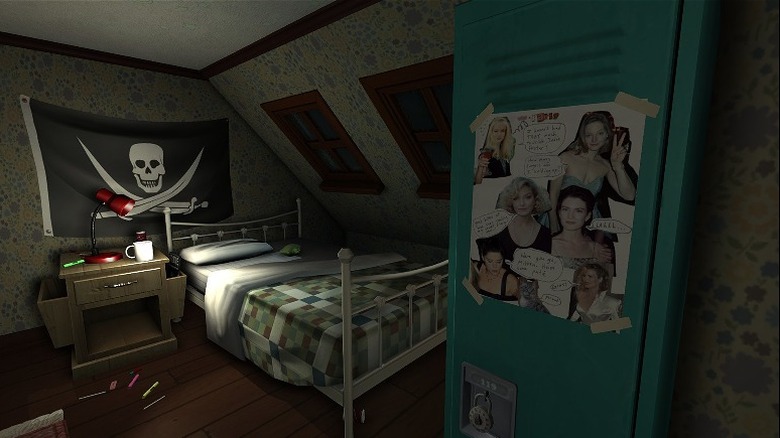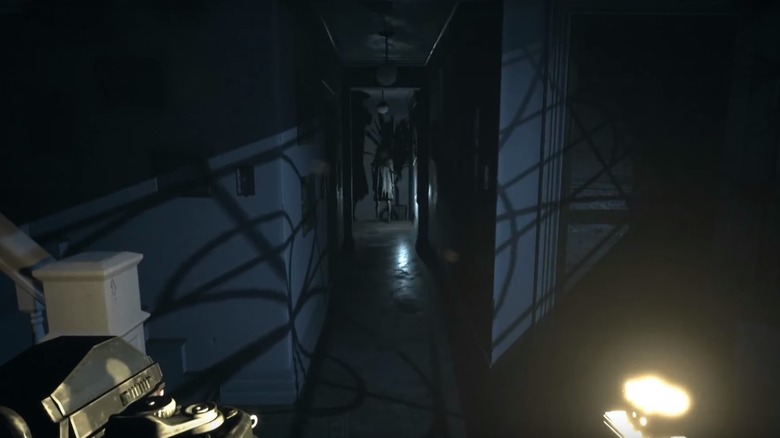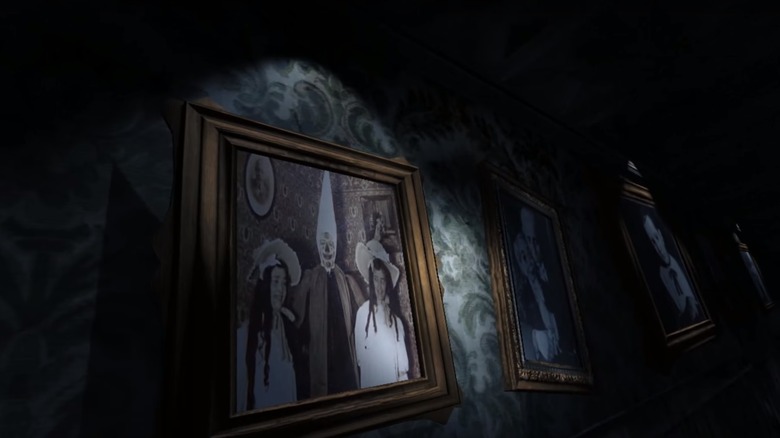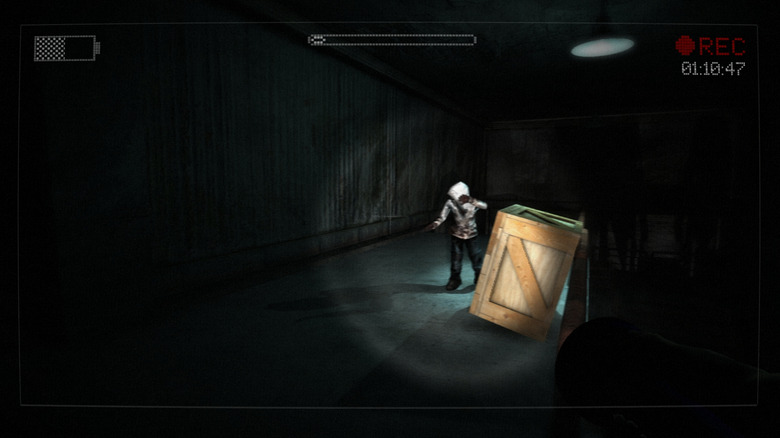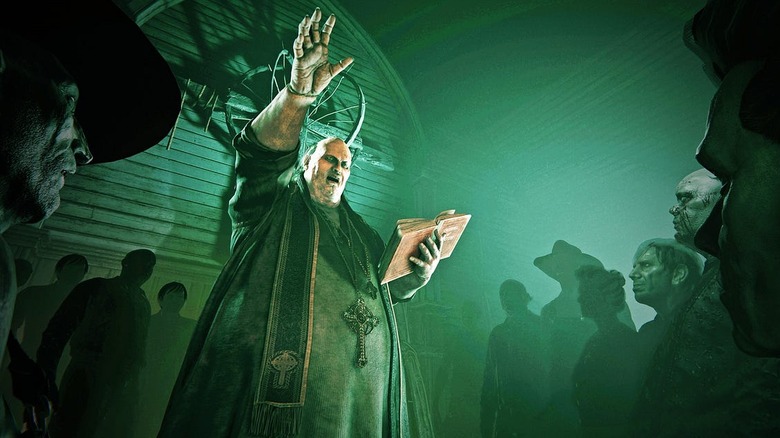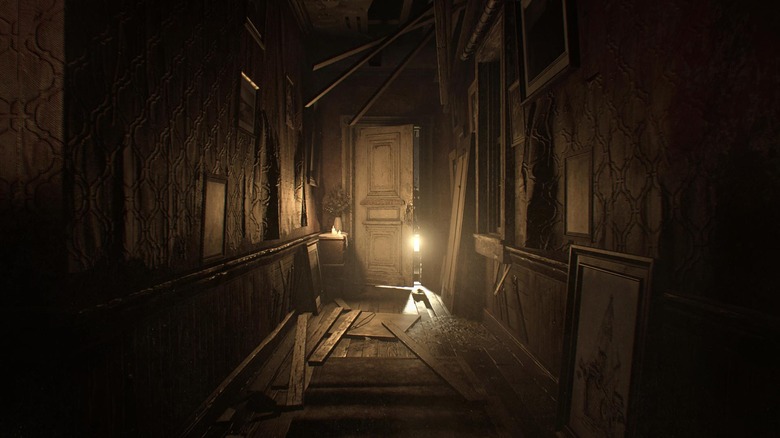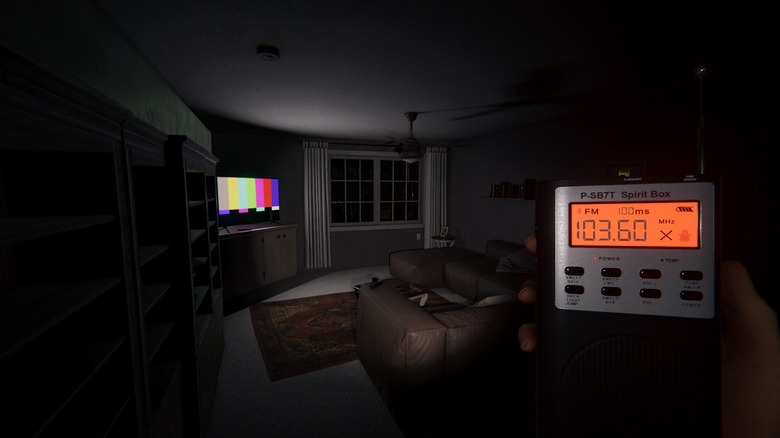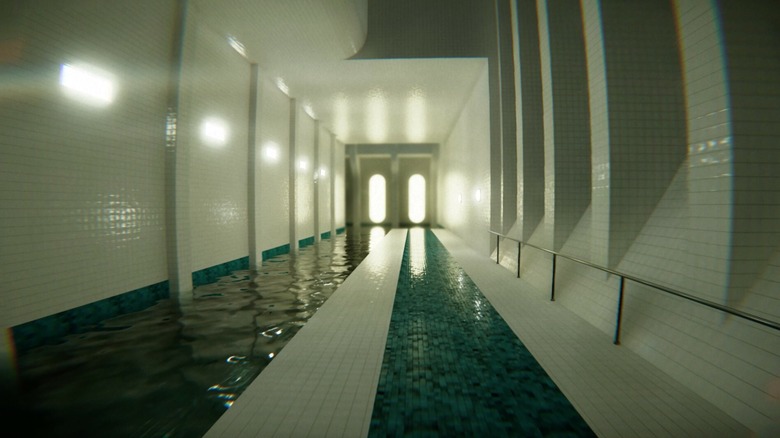Video Games You Should Never Play By Yourself
It's late. The lights are down low. The latest horror video game is in the console. Before embarking on your next virtual nightmare, there's some hesitation to pushing the start button. Do you really want to play this alone? We've all been there. There's nothing to be ashamed about. Just like the greatest scary movies are better to witness with others in the room, so are some of the best terrifying video games.
It's definitely not because we're afraid of things in the dark, but because we want others to be there to experience all the frights these games provide with us first-hand. We can't help it if that also means we have someone to hold us when things got too spooky.
P.T. (Silent Hills)
Released as a demo during E3 2014, "P.T." was a mysterious new spookfest crafted exclusively for the PlayStation 4 by the pseudonymous 7780s Studios. Players were dropped into a barren room with a single door, and on the other side was a seemingly innocuous hallway that repeated on a loop until gamers met certain exploration requirements. Eventually, an apparition of a deceased woman named Lisa appeared out of nowhere. Suddenly the halls changed into something akin to the "Amityville Horror." That's when things got weird.
Radio transmissions recalled murderous events. A discarded fetus talked to players in a bathroom sink. The hall turned to a hellish path of evil eyes. All while Lisa laughed and chased players through her home. Not only did players need someone nearby to keep them from losing their minds, but those extra eyes helped solve the game's obtuse riddles, even if they were peeking out from behind closed hands.
Though early players were thrilled that there was a new horror game coming to the PlayStation 4, "P.T." earned more fans when they discovered its initials stood for "playable teaser." "P.T." was actually hype for a new "Silent Hill" game from the minds of Hideo Kojima and Guillermo del Toro. Unfortunately, Konami and Kojima Productions parted ways before Silent Hills could be completed. The demo is all that remains for those lucky enough to have downloaded it back in 2014 before Konami yanked it from the PlayStation store.
Siren: Blood Curse
Thirty years after the inhabitants of Hanuda Village disappeared without a trace, an American television crew arrived to document the remnants of the town for an anniversary special. Soon, the journalists find themselves in the middle of an ancient ritual, complete with sacrifices, the undead, and nightmare creatures straight out of a Junji Ito manga. And of course, we can't forget the ominous air raid sirens that mysteriously call through the darkness in Hanuda Village.
"Siren: Blood Curse" was a 2008 re-imagining of the cult favorite "Siren" series for the PlayStation 3. Rather than being a straightforward experience, developer Project Siren focused on an episodic narrative told through the perspectives of a half-dozen different characters, each of whom was visiting Hanuda Village for different reasons. At the center of the game's story sat an ancient god named Kaiko, who was the reason the undead rose, why the village was cut off from the outside world, and who was responsible for the grotesque menagerie of horrors hidden in every corner of Hanuda Village. In addition to being crazy-scary every time a new creature appeared out of thin air with its soulless, bloody eyes, the episodic nature of "Blood Curse" made it perfect for binge-playing with friends.
Dead Space (2008)
They say that in space, no one can hear you scream. While the science behind that statement may be true, it's not something that applies to trips to space in a video game. One hour with 2008's "Dead Space" was enough to prove that. Developed by EA's Redwood Studios, which went on to become Visceral Games, "Dead Space" was a brilliant third-person, action-horror game that terrified players from the moment they stepped foot on the USG Ishimura.
As engineer Isaac Clarke, gamers went head-to-head with a new galactic menace, the necromorphs. These creatures were once human, but were infected by a massive, ancient spire that seemingly had a connection straight to your worst visions of the monster in the closet. Not only were necromorphs nasty creatures, they were also tough to beat. They had to be dismembered in order to be vanquished, and while it was a great video game mechanic, it made every encounter a white-knuckle battle.
To make things even more dramatic, the AI for the necromorphs always made them incredibly aggressive. While that might mean one necromorph would come at you head on at top speed, it also meant that groups of necromorphs would find different paths of attack so they didn't gum up a hallway. Isaac was never truly safe, which meant players were never at ease. The 2023 remake would come close to this level of tension, but there's just something about the dark grime of the original that makes it feel like you've just stepped into hell in space.
Layers of Fear (2016)
Polish developer Bloober Team had a handful of unremarkable games for portables and mobile devices under its belt before striking psychological horror gold with "Layers of Fear." Practically coming out of nowhere, this game was an unexpectedly chilling delight that followed a disturbed artist as he tried to complete his masterpiece. Players had to explore his home to discover how to finish this painting, and uncovered a great mystery as the story progressed.
"Layers of Fear" wasn't full of monsters or things trying to kill you, but it was an eerie experience, loaded with jump scares. Though first-person horror games have often relied on jump scares to keep players on their toes, the game's atmosphere is what made it truly creeptastic. The painter protagonist went more than a little bit mad, and his artworks were horrific and violent affairs that would give anyone staring at them goosebumps. Exploring darkened halls of a Victorian manor never felt so tense as it did in this game. As for that masterpiece? We won't spoil all the fun of what happens during the course of the game, but you definitely won't expect all the twists and turns Bloober Team incorporated into the narrative. Depending on each player's experience, one of three different endings is possible too, adding more depth to the decaying mental state of the main character. Two sequels followed, but the original still holds a dark place in our hearts.
Until Dawn
Supermassive Games' Until Dawn was in development for years before it finally saw the light of day on PlayStation 4 in 2015. Originally conceived as a PlayStation 3 game with a heavy focus on Move controls, Until Dawn featured Hollywood stars like Rami Malek and Hayden Panettiere in a slasher film heavily steeped in horror film tropes. What helped Until Dawn stand out and thrive in spite of years in development was the "choose your own adventure" style gameplay. Giving players even a modicum of control over each character's fate lent much more appeal than any number of similar scripted experiences.
Until Dawn is best played with others not because of its scares, but so your friends can also partake in the action. All of the gameplay is pretty simple, with quick-time events making up the bulk of interactivity, so even more casual gamers can get in on Until Dawn without feeling too pressured to perform. What's more, failure doesn't result in a game over, but instead just leads down another path towards one of Until Dawn's numerous different endings.
All those choices and possibilities also mean Until Dawn is the perfect game for replaying with different friends to learn which of your pals would have the best chances of survival if they were stranded in a cabin in the woods.
Silent Hill: Shattered Memories
The "Silent Hill" series is known for being a very atmospheric and downright terrifying horror franchise. Though the early PlayStation games certainly get a lot of the credit for establishing the tone, the lone Wii game in the family certainly earned its place by being just as tense and frightening as any encounter with Pyramid Head. As a re-imagining of the original "Silent Hill," "Shattered Memories" put players back in the role of Harry Mason as he searched for his daughter after a car crash on the outskirts of town. Armed with only a flashlight and his cellphone, Harry must solve puzzles and explore the abandoned depths of the snowy town, while also dealing with being transported to the alternate nightmare dimension.
There's no combat in "Shattered Memories," so you can only evade Silent Hill's monsters — or else find yourself trapped forever in the nightmare realm. If all that wasn't creepy enough, the game also incorporated the Wii controller to act as the cellphone, as messages and calls came through the device's speaker. Now that's creepy.
Amnesia: The Dark Descent
You probably never thought you'd be truly afraid of the dark in a video game, but the darkness in "Amnesia: The Dark Descent" will certainly give you reason to reconsider. Set in the 1800s, the game put players in the role of an amnesiac named Daniel who must escape from the depths of an old castle, while also trying to piece together how he even ended up there in the first place. Oh, and Daniel must also manage his sanity by not spending too much time in the shadows and dark–otherwise he hallucinates, making his escape that much more difficult.
The game's sanity meter helped set it apart from a number of other first-person horror games, particularly when players weren't playing close enough attention. The auditory and visual cues that crept into Daniel's mind made discerning from real danger nearly impossible, and the more time spent in this frantic state, the more visceral the psychological terrors became. Uncovering the truth behind Daniel's entrapment and the horrors the castle walls hold increased the tension, but it also gave players a reason to keep going even if they were absolutely out of their minds. Or were they?
Bloodborne
Okay, it's true: "Bloodborne" isn't traditionally scary. There aren't many frights you don't see coming, and the action-intensive focus of the gameplay doesn't serve as a great mold for a spookfest either. Even with that all in mind, the Gothic horror at the center of "Bloodborne" and its creature design is downright gnarly. Heavily inspired by the works of H.P. Lovecraft and Bram Stoker, the nightmare landscape of "Bloodborne" is what makes it such a necessary title for this list.
A great deal of horror games focus on traditional mythic undead monsters, but the influences in "Bloodborne" gave it a much more creative creepiness. Let's be real. There are very few games that feature bosses as uneasy on the eyes as the Blood-starved Beast, Ebrietas, and The One, Reborn. At least with Lovecraft, you know you're getting a tentacle monster or two. This game's bosses scoff at such simplistic nether-gods. If you don't have 65 skulls popping out of glowing orifices, each with their own mutated baby brain, you aren't tough enough to make it in the land of Yharnam.
Lone Survivor
A 2D side-scroller set in a post-apocalyptic nightmare world, "Lone Survivor" is arguably the scariest pixel art game you'll ever play. After a disease has turned most of the population into bloodthirsty monsters, the nameless protagonist must search for supplies in order to stay alive on his own. After exploring the world for a bit and scavenging, the protagonist returns home to sleep with the aid of blue or green pills. The pills give him different dreams, and can help change the outcome of the game's various endings.
Though you can battle some of the monsters in the world, stealth is just as important. Players can use diversionary tactics like leaving meat behind to draw out monsters, or they can stay in the shadows to avoid contact when possible. Like the early survival horror games, weapons are in short supply and saving what you've managed to collect comes in handy against some of the larger threats in the world. "Lone Survivor" is unsettling and mysterious, and definitely keeps players on their toes considering they can only see so much of the game world at a time. Don't play this one before you go to bed, unless you like having really messed up nightmares.
Alien: Isolation
There have been numerous "Alien" games, but it wasn't until developer Creative Assembly went back to the mold of the original 1979 movie that we got an "Alien" game that made players afraid of the dark once more. "Alien: Isolation" put players in the role of Ellen Ripley's daughter, Amanda, as she tried to uncover the fate of her mother's derelict ship. Unfortunately for her, and everyone aboard the space station where "Isolation" takes place, a xenomorph is on the loose.
"Isolation" calls back to the wonderful design and atmosphere of Ridley Scott's film, with stark corridors filled with barely-there ambient light. Most of "Isolation" pits Amanda against a lone xenomorph as it hunts her down through each and every section of the station. Creative Assembly created a spectacular dual-intelligence for the creature, with one brain controlling its body, and the other providing hints as to the player's whereabouts throughout the game. The AI keeps tensions high, not only making every new hallway terrifying, but exhausting players mentally by forcing them to constantly be on the defensive. Couple that with a haunting score culled from the original film, and you've got a game that's barely safe to play in broad daylight with all the house lights on.
Fatal Frame 2: Crimson Butterfly
The "Fatal Frame" series has always had a cult following among video game horror fans, but its first sequel remains one of the most celebrated and fondly remembered. And that's in spite of literally forcing players to face their fears directly with the only "weapon" they're armed with: an antique, mystical camera. "Crimson Butterfly" follows a set of twin sisters as they explore the haunted town of Minakami Village. This fictional town earned the nickname "The Lost Village" as part of an urban legend when many of the denizens disappeared under mysterious, ritualistic circumstances. The twins are trapped in the town until they can take enough pictures of the spirits trapped by malevolent forces, thus freeing the dead in the process.
Taking pictures of ghosts to weaken them may sound like an absurd gameplay mechanic, but try actually playing this game and see if you feel the same way. Slowly learning the truth about the spirits certainly makes dealing with some of the most intense boss encounters in horror games worth the cold sweats. Even years later, this game's true legacy is the lingering thought of spotting something abnormal just outside of the frame in any real picture players try to take.
Deadly Premonition
Like the other entries on this list, "Deadly Premonition" is one that's best experienced playing with others. Unlike other games that are too spooky to encounter alone, "Deadly Premonition" is worth having someone to play with due to its unique approach to storytelling. Imagine if you will, "Twin Peaks" meets "The Room." That's just about where "Deadly Premonition" starts, and it only gets weirder from there.
As FBI agent Francis Morgan, players arrive in Greenvale to solve the murder of a teen girl. This death bears a striking similarity to several others across the country, but it's the Greenvale case that takes things up a notch with its numerous supernatural elements. Oh, and there's the presence of a second bad guy, the Raincoat Killer, that Francis must deal with while trying to solve the case. We haven't even talked about the government conspiracies, odd psychological elements, or that Francis might not be as reliable a protagonist as expected.
"Deadly Premonition doesn't" have the greatest visuals, or a memorable soundtrack, and the characters are so bizarre, it's almost hard to believe this game made it out of development at all. Still, that lack of polish and abundance of absurdity is what makes "Deadly Premonition" such a fantastically good-bad game. And one you definitely want to play with some friends around to witness.
SOMA
"SOMA" is a game so terrifying and challenging that developer Frictional Games released an update to it that removed all monster encounters to make the experience more palatable for players. That alone should give you some indication of just how frightening it is trying to survive in an undersea research station. After a worldwide cataclysm, the only people left alive on Earth are the inhabitants of the PATHOS-II. Players take on the role of Simon Jarrett, as he must explore the station to uncover a way off Earth so humanity can survive. "SOMA" plays with solitude and what life for a limited group of survivors must be like after the apocalypse, as well as touches on some more metaphysical ideas of consciousness and the sense of self.
Those portions are just the brilliant foundation for the terrors of the depths, as "SOMA" requires players to survive against beings that don't believe in the human race. Of course, that's just the original vision, which provides a number of scares and jumps along the way. In Safe Mode, the atmosphere is still haunting enough that you may want a co-pilot nearby. Plus, you'll automatically have someone to talk with about the game's narrative when it's all over.
The Evil Within
After creating the "Resident Evil" series and ushering that franchise into legendary status, designer Shinji Mikami turned his attentions to a new horrifying game. Mikami believed the survival horror tropes had evolved to the point where players weren't so easily scared anymore. So with "The Evil Within," he and his development team made sure to instill panic and tension in players by relying on some classic tricks. Almost all of the game's battles take place in tight, confined spaces, making escape from whatever disgusting creature is chasing you feel nearly impossible. Ammunition and weapons are in short supply, meaning every shot and strike must count, otherwise some weird guy with a safe for a head may chop you in half. Oh, did we forget to mention the nightmarish character designs?
Yeah, "The Evil Within" is full of nasty-looking folks looking to put you down for good. Some may have barbed-wire heads; some might look as if they were caught in an explosion in a glass factory. They're all creepy and violent, but what makes the world scarier is the idea that something more monstrous is the driving force. These creatures are out to get you, but like you, they're just victims of a greater evil... (wait for it)... within.
Silent Hill 2
When considering the scariest video games ever conceived, "Silent Hill 2" must be part of the conversation. The franchise's earliest days are still looked upon with the fondest of memories, with the first sequel in particular standing above its brethren with its gut-wrenching story, hellish landscape, and being the first entry to introduce the brutal villain known as Pyramid Head. Lead character James returns to the town of Silent Hill after getting a letter from his dead wife. But instead of finding her, all James is able to uncover are revelations about his own guilt and remorse. While survival horror games have traditionally been rooted in escaping from literal monsters, the game's excellence comes from the layered approach of terrorizing its characters psychologically and figuratively.
It's eerie, and the horrors abound at every turn, so playing "Silent Hill 2" alone is a true challenge for the bravest of souls. Seriously, there are fewer characters that instill fright in aging gamers than the visage of Pyramid Head. Still, even facing the series' hallmark grotesque nurses doesn't quite hold a candle to facing James's own demons–and those memories are what linger long after the last emergency siren has blown.
F.E.A.R.
Though "F.E.A.R." is revered for being a first-person shooter with some of the best artificial intelligence in the genre, it's also home to more than its fair share of creepy supernatural elements. For much of the campaign, players are rewarded with sharp shooting and challenging computer opponents. Like all good games, just as players become their most powerful, they encounter new and tougher elements to put them back in their place. Oh, you just cleared out a huge room full of bad guys? Then where did that little girl come from over in the corner? And how did she suddenly appear right in your face? If the world wasn't already terrified of pale, creepy children at the end of dark corridors, "F.E.A.R." ensured we'd walk away from them forever if we ever saw them again.
Lights dim. Body parts and pools of blood appear. What was once a very good shooter immediately turns into a very good shooter that has you jumping at every moment. Whatever reflexes you had are shot, making surviving the game that much more challenging.
Condemned: Criminal Origins
The Xbox 360 had such an incredible library, it's easy to forget about the games that first helped launch the console back in 2005. "Condemned: Criminal Origins" is one of the few original Xbox 360 games that has withstood the test of time, and it's still one of the more terror-filled titles to hit Microsoft's second console.
In the role of Ethan Thomas, players try to solve the murders of a serial killer known as the Match Maker. The killer has a penchant for elaborately staging crime scenes with mannequins, and it's one of the reasons some gamers still get the creeps around undressed mannequins to this very day. "Condemned" is a thrilling experience for players, who use rudimentary CSI tools like a black light to track blood trails, battle vagrants with brutal melee combat, and creep through barely lit, ominous settings. Even today, "Condemned: Criminal Origins" still holds up fairly well, especially when playing by yourself. The scares will have you jumping, the tension is palpable, and the shadows are still filled with things you don't necessarily want to shine a light on. Especially those mannequins.
Alan Wake
Few developers have a penchant for mixing storytelling and action in the way Remedy does, which is what helps make "Alan Wake" such a unique thriller compared to the rest of the games we've been talking about. Though "Alan Wake" isn't an outright frightfest, it's a well-crafted mystery in a town that recalls echoes of "Twin Peaks" and Stephen King's "The Dark Half," where an author must confront elements of his latest suspense novel that have come to life.
The episodic structure of "Alan Wake" keeps pacing on point, constantly moving players towards the ultimate goal of finding out what the heck is happening, while also deepening the mystery with every chapter. While trying to get to the bottom of a bizarre occurrence, Alan must also fend off the darkness and actual shadow creatures that aren't just out to kill him, but everyone that lives in his town, too. "Alan Wake" won't have you gripping your significant other's hand in fright, but it will keep you from ever taking up writing that great American novel you've been planning. Unless you're already almost finished. In that case, it's already too late.
The game's sequel took things in an even more intense survival-horror direction, but there's an eerie playfulness to the original that still gets under your skin like nothing else.
Gone Home
Sometimes the things that haunt us most aren't actual ghosts, but the specters of a life missed. Such is the case for "Gone Home," a simple adventure game where the only goal is to find out what happened to your family while you were away. Few games could capture the essence of living in someone else's shoes quite like "Gone Home" did when it released in 2013, but that hasn't stopped a wealth of similar games from coming out in the years since. Good as those likewise games may have been, "Gone Home" is still in a class all its own for the novel way in which players uncover the truths about the Greenbriar family. From listening to music and reading notes, to finding objects and merely observing tiny details throughout this lived space, "Gone Home" reveals a mystery that keeps your attention from start to finish.
You may not leap from your seat due to any jump scares, and there aren't any deranged killers stalking you through the Greenbriar estate. But even without those elements, "Gone Home" is as haunting and memorable as any game on this list, and it's certainly one worth witnessing with someone close to you so you don't become ghosts in each other's lives.
Visage
SadSquare Studio's 2018 survival horror game "Visage" was highly anticipated since it was first announced in 2015. Early previews of the game revealed it to be something of a spiritual successor to "P.T." As fans of the survival horror genre were unanimously upset by the cancellation of "Silent Hills," "Visage" seemed like a perfect replacement to give fans of horror the scream-fest they so desperately wanted.
As with "P.T.," players find themselves in a photorealistic home, stalked by a force that frequently remains unseen. The subtle changes in the surrounding environment begin to convince you that you might just be seeing things. As your protagonist wanders the house trying to piece together the violent history of past tenants, players must worry about their sanity while attempting to stay in well-lit areas and away from the horrors that will make you lose your mind. Because the house is set up in a semi-open-world format, you are given free rein of the environment, including rooms that aren't relevant to the plot or puzzles. This open environment only builds the tension, as you never know when something will come for you and the large map makes escape particularly tricky.
Affected: The Manor
Horror games have found their perfect partner with the rising popularity of virtual reality. The immersive nature of VR has challenged game developers to create suffocating environments where it feels like something is waiting for you around every corner, and the sheer number of survival horror VR games in recent years shows that they have accepted the challenge.
Touted as the "original VR horror experience," "Affected: The Manor" puts players in a realistic haunted house full of ghosts, jump scares, and far too many dolls. The house itself is just as much a character as any of the horrors found within, oozing with personality added by set dressing and atmosphere. The long narrow hallways and labyrinthine corridors force players around corners and down staircases where horrors are almost always waiting within your limited line of sight. Between the terrifying young girl who stalks you throughout the house and an ouija board seance session that you are unwillingly forced to participate in, players will find their nerves raw and their tension level high. With jump scares that are smart and well-paced, this isn't a game you want to play by yourself.
Slender: The Arrival
Unless you've been living under a rock, chances are you've heard of the long-limbed antagonist who doesn't appreciate being looked at named Slenderman. Born from an internet contest, this nightmare has been haunting our screens for years in one form or another. From movies to games and creepypastas, Slenderman is a true modern urban legend. Of all of the creature's incarnations, Blue Isle Studios' 2013 survival horror game "Slender: The Arrival" may be the best known and most feared.
In "Slender: The Arrival," you play as Lauren, childhood friend of Kate from the game "Slender: The Eight Pages." There are numerous tasks and mechanics throughout the different areas of the game that keep players on their toes, changing the rules as soon as they get comfortable. Between trying not to look at Slenderman in the forest to making sure that you shine your flashlight on the Chaser in the mines, all of the different rules can get confusing. Mixed with the panic of suddenly seeing an enemy and having to make a split-second decision on which rule to follow, and "Arrival" will keep your heart rate elevated throughout your entire playthrough. The jump scares aren't in short supply on this game, so make sure you're in a well-lit and populated area before you play it.
Outlast 2
The "Outlast" games by Red Barrels aren't exactly known to be casual, light-hearted walking simulators. Both games in the series serve as horrific nightmare fuel with grotesque imagery and heart-pounding chase sequences. "Outlast 2" is no exception to this rule, what with its overt religious undertones and elements of mob mentality and mind control. And of course it doesn't help that your pesky flashlight never seems to last quite long enough to get you where you need to go.
Taking place in the derelict town of Temple Gate, "Outlast 2" has you playing as Blake Langermann, a cameraman and investigative journalist looking into the death of an unidentified young pregnant woman. His investigation takes him to Arizona where a crash-landing strands him in Temple Gate with no knowledge of where his wife is and no shortage of incredibly unpleasant cult members to contend with. Though the idea of having to conserve your stamina and your batteries is a common mechanic, "Outlast 2" does it so well that you'll feel tense long after you've turned the game off. The sense of being claustrophobic and dangerously exposed all at the same time is enough to put anyone into a panic, and as the story unfolds, the plot only makes gameplay that much more horrifying. Needless to say you won't look at Catholic schools or Arizona the same way ever again.
Resident Evil 7: Biohazard
While horror games are already terrifying enough on their own, the option to play through these games in VR has only added to the terror. If there's one thing VR is good at, it's making the player feel totally immersed in an environment. The only problem is that may not be entirely desirable if the environment is the Baker home from "Resident Evil 7: Biohazard." Though "Resident Evil 7" is scary enough to play through on console, when you place that VR headset on to experience the nightmare in a fully immersive way, you'll find that you're scared of more than just the Bakers themselves.
""Resident Evil 7" has been praised as one of the most innovative and horrifying in the storied franchise. Even when placed against the fan favorites of the past, this installment really raised the bar. Having to solve intricate puzzles and use stealth to navigate your way through the Baker home replaced the normal "grab a gun and kill some zombies" formula. This new, smarter version of horror forced players to remain calm enough to solve difficult problems while still keeping their adrenaline high enough to get themselves out of harm's way throughout the game. This constant balancing act helped to create the perfect horror game that will haunt players with not only jump scares, but slow-burn terror as well. Needless to say, this isn't a game you want to play alone.
Doki Doki Literature Club
If you're casually scrolling through Steam, you might go right past "Doki Doki Literature Club" without realizing that it's one of the scariest games you can play today. The cartoony art style and visual novel category tag aren't usually associated with experiences that will make you sleep with the lights on, but "DDLC" can be downright unnerving, especially if you're playing the game by yourself.
"DDLC" is set in an unassuming high school, and as the title implies, its story involves you joining the school's literature club in what starts out as a cute slice-of-life story. Over the course of just a handful of hours, the game goes from easing you into its world to ratcheting up the tension so high you'll go from feeling excited to just plain paranoid. We can't say much without spoiling the overall experience, but what makes the horror in "DDLC" so effective is that it's not just contained to the in-game world itself. The game has a way of working the player itself into the narrative, and that personal involvement makes "DDLC" so terrifying you'll never forget it.
Phasmophobia
"Phasmophobia" is a multiplayer VR game that puts you in the shoes of a professional ghost hunter. Don't think the presence of a small party of other players will keep you safe, though. Even if you've got a full team of friends with you, we wouldn't recommend putting on that VR headset unless you've got a few other people physically in the room with you. From haunted houses to abandoned high schools, the locations that you explore in "Phasmophobia" perfectly set up a bone-chilling atmosphere, but that's just the beginning.
Once you've gotten up the courage to grab a EMF meter and a flashlight and actually head into that old farmhouse up the road, you're going to have to contend with a haunting straight out of the spookiest horror movie you've ever seen. The goal of the game is to gather enough ghostly evidence to pin down what kind of haunting is taking place, but if you aren't quick, the ghosts will come for your life. You can still communicate with friends via the in-game walkie-talkie while the lights flicker on and off, screeching and ghostly moaning fill the air, and a vicious demon chases you down — but trust us when we say you don't want to pull your headset off to find yourself all alone in a dark room.
Pools
Playing "Pools" alone at night is a surefire way to get a bad night's sleep. Gameplay-wise, "Pools" is essentially a walking simulator. All you can really do is slowly make your way through the game's bizarre and beautiful environments, but that limitation is part of the horror. The areas you'll explore in "Pools" are sprawling underground hallways and clinical tiled rooms that have come to be filled with water. Each room looks like a dream-distorted version of some place that could exist in reality.
As you explore the surreal rooms and halls, you'll find yourself pursued by ... something. The magic of "Pools" is that basically nothing happens to you as you explore, but the atmosphere that the game sets has a way of making your imagination kick into overdrive. Around every corner, you'll catch sight of something watching you. As you wade through eerie bodies of water, you'll feel certain that something is going to pop out and grab you. That big shocking moment might never come, but when you're sitting alone after a session of playing "Pools," all that built up paranoia is going to have you seeing ghosts in your own home.

